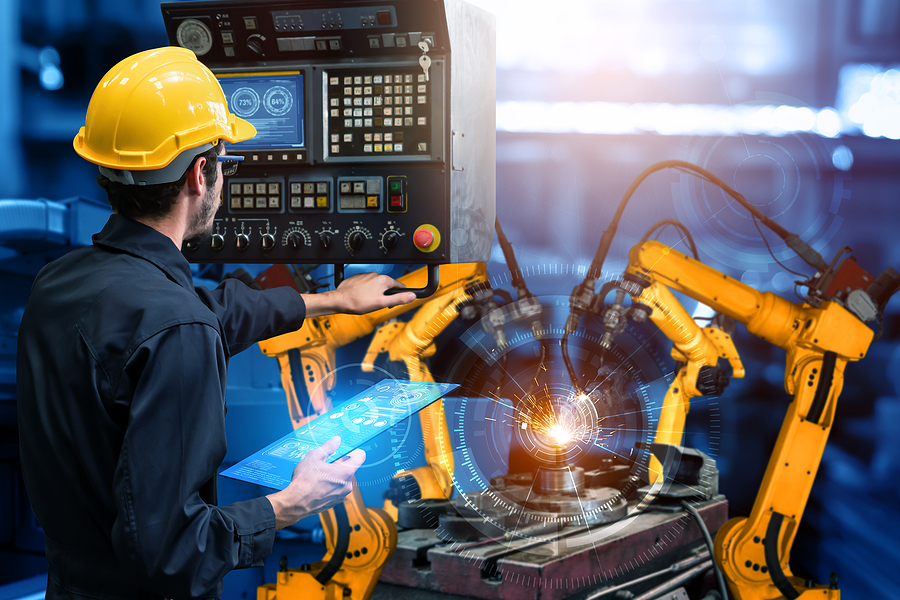Like many areas of technology, artificial intelligence (AI) gained more attention and interest with the rapid and drastic changes to work environments that 2020 experienced. Still, mid-sized manufacturers may relegate AI usage to the bigger players in the marketplace. In reality, AI is for many different types and sizes of businesses. With manufacturers of all sizes needing to adapt to new realities, AI could be a major player for them:
- AI has the potential to transform performance and quality across the spectrum of manufacturing operations. As more manufacturers adopt Industry 4.0 technologies, like the Internet of Things (IoT), AI will be needed to help analyze data for value-added tasks such as predictive maintenance or performance optimization.
- Analyst groups like IDC and Gartner forecast that spending on AI will grow significantly in the next three years. They predict that AI spending in 2023 will be more than two and a half times the spending level of 2019 (IDC Worldwide Artificial Intelligence Spending Guide).
AI needs some serious consideration. Using AI in a manufacturing business comes with measurable benefits, such as the ability to automate a process to augment human ability, optimize the efficiency of a process and enhance the ability of people to accomplish tasks, or enable them to do something they typically could not.
7 Ways AI Can be Used in Today’s Manufacturing
Let’s look at the emerging role of AI in manufacturing. Manufacturers have a number of use cases to consider when kick-starting an AI journey.
- Predictive maintenance: Combining AI in manufacturing with data from IoT sensors and other sources enables better prediction and avoidance of machine failure. Capital equipment productivity can be increased up to 20 percent, while maintenance costs may be reduced by up to 10 percent.
- Yield enhancement: AI-supported manufacturing can experience decreased scrap rates and testing costs by linking many variables across machinery groups and sub-processes.
- Quality testing: AI-based image recognition can significantly increase the detection of defects as compared to human inspection. Because AI systems can learn continuously, performance continues to improve over time.
- Supply chain management: Using AI can improve forecasting accuracy at an increased SKU granularity with a reduction in errors between 20 and 50 percent and inventory reductions of 20 to 50 percent. This is achieved by analyzing and learning from various data sources, such as warehousing and inventory data in an ERP system, as well as from external sources like social media information.
- Research and Development: AI in manufacturing can improve product design by iteratively testing and learning. This can optimize designs and suggest solutions that may appear unconventional to the human mind.
- Shop floor operations: Combining real-time monitoring through sensors with AI can optimize shop floor operations, providing insights into machine-level loads and production schedule performance. AI can analyze large amounts of data coming from sensors far more effectively than humans and make recommendations in near real-time to assist human decision making.
- Health and safety: AI can be used to get a better understanding of risk factors on the shop floor and can help make operations safer.
Start, Scale, and Test AI
Due to its newness in the market, AI projects will often be implemented as small-scale prototypes in live environments. This gives users the time to navigate it and learn about any issues.
The first step is to get the AI prototype processing data in real-time from the shop floor or warehouse. Automating the collection of real-time data from live production operations will require integration to a manufacturing operation management or manufacturing execution system; this can be assisted by data from IoT sources.
Scaling beyond the prototype phase is not a challenge to be under-estimated. Performance needs to be continuously monitored for quality, reliability, and value generated. However, once the AI solution is proven and ready, the application can be deployed and made available across multiple sites. As you scale up and apply AI, it learns across divisions and geographies, extracting additional value.
Be sure to also adopt procedures for auditing and testing to ensure AI risks are understood and addressed throughout the organization.
Is it Time for AI in Your Business?
If you are still wondering whether to go the AI route or not for your manufacturing business, remember that if you do not change the way you operate, the tools you use, and the degree of automation you choose, your industry and competitors will, and your customers will move on.
Are you ready to explore adding AI to your ERP? Or perhaps it’s time to upgrade your ERP so that it can handle adding AI. Take the next step by requesting your free software consultation from an ASI cloud expert today.

